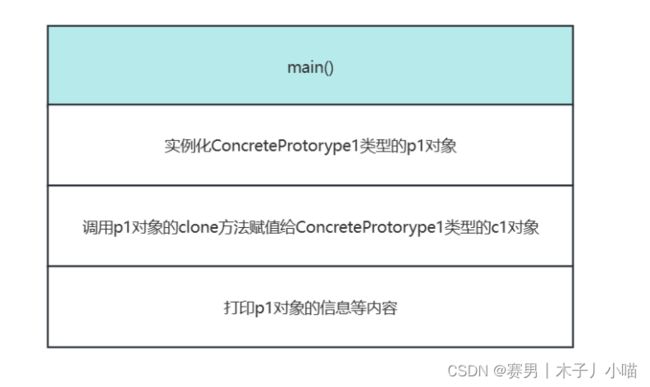设计模式之原型模式--超越实例化的魔法,从复制到创造的无限可能
目录
- 概述
-
- 什么是原型模式
- 浅拷贝和深拷贝
- 类图
- 原型中的主要角色
- 工作流程
- 代码衍化过程
-
- 初版
- 原型模式基本代码
- 简历的原型实现
- 浅复制
- 深拷贝
- 原型模式的优点
- 原型模式的应用场景
- 原型模式的创新
- 总结
概述
什么是原型模式
原型模式是一种创建型设计模式,它允许通过复制现有对象来创建新对象,而无需依赖显式的实例化过程。使用原型模式,我们可以在运行时动态地创建对象,并且能够轻松地生成对象的副本。
浅拷贝和深拷贝
在原型模式中,复制对象的方式通常可以分为浅拷贝和深拷贝两种。
- 浅拷贝:浅拷贝创建一个新对象,该对象与原始对象共享一些属性。这意味着新对象中的引用类型属性仍然引用原始对象中相同的对象,对引用类型属性的更改会影响到原始对象和所有浅拷贝的对象。
- 深拷贝:深拷贝创建一个新对象,该对象与原始对象完全独立。这意味着新对象中的引用类型属性指向新的对象,对引用类型属性的更改不会影响原始对象或其他深拷贝的对象。
在选择浅拷贝还是深拷贝时,需要根据具体的需求和对象结构来决定。
类图
原型中的主要角色
-
原型(Prototype):原型是一个抽象类或接口,定义了可以复制自己的方法 clone()。具体的原型对象需要实现这个方法来进行对象的复制。
-
具体原型(Concrete Prototype):具体原型是实现了原型接口的具体类。它通过实现 clone() 方法来复制自身,并生成一个新的对象,保持与原始对象相似的状态。
-
客户端(Client):客户端是使用原型对象的地方。它通过请求原型对象来创建新的对象实例,而无需直接调用构造函数进行实例化。
工作流程
在原型模式中,客户端通过以下步骤使用原型对象:
代码衍化过程
业务需求:打印简历
初版
业务:打印个人简历,包括个人信息,工作经历
//简历类
public class Resume {
private String name;
private String sex;
private String age;
private String timeArea;
private String company;
public Resume(String name){
this.name=name;
}
//设置个人信息
public void setPersonalInfo(String sex,String age){
this.age=age;
this.sex=sex;
}
//设置工作经历
public void setWorkExperience(String timeArea,String company){
this.timeArea=timeArea;
this.company=company;
}
//展示简历
public void display(){
System.out.println(this.name+" " +this.sex+" "+this.age);
System.out.println("工作经历"+this.timeArea+" "+this.company);
}
//客户端
public class Client {
public static void main(String[] args) {
Resume resume1=new Resume("张三");
resume1.setPersonalInfo("男","22");
resume1.setWorkExperience("2020-2023","XX公司");
resume1.display();
Resume resume2=new Resume("张三");
resume2.setPersonalInfo("男","22");
resume2.setWorkExperience("2020-2023","XX公司");
resume2.display();
Resume resume3=new Resume("张三");
resume3.setPersonalInfo("男","22");
resume3.setWorkExperience("2020-2023","XX公司");
resume3.display();
}
}
}
一个简历类,在客户端中通过实例化简历类传入相同的信息来实现打印多份简历
问题:客户端麻烦,打印几份简历客户端就是要实例化几次,而且调整简历内容,每个都要调整。
引入原型模式
原型模式基本代码
//原型
abstract class Prototype implements Cloneable{
private String id;
public Prototype(String id){
this.id=id;
}
public String getId() {
return id;
}
//原型的关键方法
public Object clone(){
Object object=null;
try {
object=super.clone();
} catch (CloneNotSupportedException e) {
System.err.println("clone异常");
}
return object;
}
}
//具体原型
public class ConcreteProtype extends Prototype{
public ConcreteProtype(String id){
super(id);
}
}
//客户端
public class Client {
public static void main(String[] args) {
ConcreteProtype p1=new ConcreteProtype("编号123456");
System.out.println("原型ID:"+p1.getId());
ConcreteProtype c1=(ConcreteProtype)p1.clone();
System.out.println("克隆ID:"+c1.getId());
}
}
运行结果

这里不用实例化ConcreteProtype ,直接使用克隆对象,对于Java而言,Prototype 是用不上的,因为Java提供了Cloneable接口,其中唯一的方法clone(),使用时直接实现这个接口就可以完成原型模式了。
简历的原型实现
//简历类
public class Resume implements Cloneable{
private String name;
private String sex;
private String age;
private String timeArea;
private String company;
public Resume(String name){
this.name=name;
}
//设置个人信息
public void setPersonalInfo(String sex,String age){
this.age=age;
this.sex=sex;
}
//设置工作经历
public void setWorkExperience(String timeArea,String company){
this.timeArea=timeArea;
this.company=company;
}
//展示简历
public void display(){
System.out.println(this.name+" " +this.sex+" "+this.age);
System.out.println("工作经历"+this.timeArea+" "+this.company);
}
public Resume Clone(){
Resume object=null;
try {
object=(Resume) super.clone();
} catch (CloneNotSupportedException e) {
System.err.println("clone异常");
}
return object;
}
}
//客户端
public class Client {
public static void main(String[] args) {
Resume resume1=new Resume("大鸟");
resume1.setPersonalInfo("男","23");
resume1.setWorkExperience("2020-2023","Xx公司");
Resume resume2=resume1.Clone();
resume2.setWorkExperience("2022-2023","YY公司");
Resume resume3=resume1.Clone();
resume3.setPersonalInfo("男","24");
resume1.display();
resume2.display();
resume3.display();
}
}
在上面的代码中,Resume 类实现了 Cloneable 接口,表明该类可以被克隆。
Clone() 方法重写了 Object 类的 clone() 方法,通过调用 super.clone() 实现浅拷贝,并返回一个克隆后的新对象。
客户端的代码就简单很多,要是想改某份简历,只需要对这份简历做一定的修改就可以了,不会影响到其他简历,而且提高了效率,不用重新初始化对象,而是动态地获得对象运行时的状态。一般在初始化的信息不发生变化的情况下,克隆是最好的办法。这既隐藏了对象创建的细节,又对性能是大大的提高。
浅复制
//工作经历类
public class WorkExperience {
//工作时间范围
private String timeArea;
public String getTimeArea() {
return timeArea;
}
public void setTimeArea(String timeArea) {
this.timeArea = timeArea;
}
//所在公司
private String company;
public String getCompany() {
return company;
}
public void setCompany(String company) {
this.company = company;
}
}
//简历类
public class Resume implements Cloneable {
private String name;
private String sex;
private String age;
private WorkExperience work;//声明一个工作经历对象
public Resume(String name){
this.name=name;
this.work=new WorkExperience();//实例化一个工作 经历对象
}
public void setPersonalInfo(String sex,String age){
this.age=age;
this.sex=sex;
}
//设置工作经历
public void setWorkExperience(String timeArea,String company){
this.work.setTimeArea(timeArea);
this.work.setCompany(company);;
}
//展示简历
public void display(){
System.out.println(this.name+" " +this.sex+" "+this.age);
System.out.println("工作经历"+this.work.getTimeArea()+" " +this.work.getCompany());
}
public Resume clone(){
Resume object=null;
try {
object=(Resume) super.clone();
} catch (CloneNotSupportedException e) {
System.err.println("clone异常");
}
return object;
}
}
//客户端
public class Client {
public static void main(String[] args) {
Resume resume1=new Resume("张三");
resume1.setPersonalInfo("男","30");
resume1.setWorkExperience("2000-2010","Xx公司");
Resume resume2=resume1.clone();
resume2.setWorkExperience("2001-2011","YY集团");
Resume resume3=resume1.clone();
resume3.setPersonalInfo("女","35");
resume3.setWorkExperience("2020-2023","ZZ公司");
resume1.display();
resume2.display();
resume3.display();
}
}
运行结果

为什么会出现这种情况,引用对象好像覆盖了前面的对象,这个需要了解一下clone()方法。
Object 类的 clone() 方法是一个受保护的本地方法。代码中的super.clone() 方法内部的实现通过调用本地方法来完成对象的浅拷贝。
实际上,Object 类的 clone() 方法的实现有一定的约束条件:
首先,clone() 方法只能被实现了 Cloneable 接口的类调用。如果没有实现 Cloneable 接口,调用 clone() 方法将抛出 CloneNotSupportedException 异常。
其次,clone() 方法返回的是当前对象的浅拷贝,即新对象和原始对象共享相同的数据引用。
这意味着,只有基本类型的字段会被复制,而对于非基本类型(如数组、集合、对象等),只是复制了引用而不是创建新的对象。
由于浅拷贝只是复制了引用而不是创建新的对象,所以在使用 super.clone() 方法时需要小心处理可变对象和引用类型的字段。如果希望进行深拷贝,需要在 clone() 方法中显式地处理这些字段,以确保每个对象都是独立的副本。
深拷贝
//工作经验类也实现cloneable接口
public class WorkExperience implements Cloneable{
private String timeArea;
public String getTimeArea() {
return timeArea;
}
public void setTimeArea(String timeArea) {
this.timeArea = timeArea;
}
//所在公司
private String company;
public String getCompany() {
return company;
}
public void setCompany(String company) {
this.company = company;
}
public WorkExperience clone(){
WorkExperience object=null;
try {
object=(WorkExperience) super.clone();
} catch (CloneNotSupportedException e) {
System.err.println("clone异常");
}
return object;
}
}
//简历类
public class Resume implements Cloneable{
private String name;
private String sex;
private String age;
private WorkExperience work;//声明一个工作经历对象
public Resume(String name){
this.name=name;
this.work=new WorkExperience();//实例化一个工作 经历对象
}
public void setPersonalInfo(String sex,String age){
this.age=age;
this.sex=sex;
}
//设置工作经历
public void setWorkExperience(String timeArea,String company){
this.work.setTimeArea(timeArea);
this.work.setCompany(company);;
}
//展示简历
public void display(){
System.out.println(this.name+" " +this.sex+" "+this.age);
System.out.println("工作经历"+this.work.getTimeArea()+" " +this.work.getCompany());
}
public Resume clone(){
Resume object=null;
try {
object=(Resume) super.clone();
this.work= this.work.clone();//对克隆对象里的引用也进行克隆,就达到了深复制的作用
} catch (CloneNotSupportedException e) {
System.err.println("clone异常");
}
return object;
}
//客户端不变
}
原型模式的优点
-
动态创建对象:原型模式允许在运行时动态地创建对象,而无需显式的实例化过程。这使得我们能够根据需要创建对象的副本,而不必依赖固定的类层次结构。
-
简化对象创建过程:通过复制现有对象,我们可以更轻松地创建新对象。这比手动设置对象的初始状态要简单得多,尤其当对象的创建过程非常复杂时。
-
减少资源消耗:与实例化相比,原型模式的对象复制过程通常更高效。它避免了执行复杂的初始化逻辑和与构造函数相关的资源消耗。
原型模式的应用场景
- 当系统中的对象数量很大,但创建和初始化对象的过程很复杂时,原型模式可以显著简化对象的创建过程。
- 当需要创建对象的副本,而无需暴露对象的创建细节时,可以使用原型模式。
- 当需要避免与对象的产生和初始化过程相关的资源消耗时,原型模式是一个很好的选择。
原型模式的创新
原型模式在对象创建的过程中,通过复制现有对象来创建新对象,从而避免了显式的实例化过程。这种动态创建对象的方式带来了一些创新和优势:
简化对象创建:原型模式使得创建新对象变得简单直观,通过在现有对象的基础上进行复制,避免了繁琐的初始化过程和构造函数的调用。相比传统的实例化方式,原型模式提供了更加简洁、灵活的对象创建方式。
动态性和扩展性:原型模式允许在运行时动态地创建对象的副本。这意味着可以根据需要创建不同类型的对象,并且可以随时修改或增加现有对象的属性和行为。这种动态性和扩展性使得原型模式在设计阶段更具灵活性和适应性。
减少资源消耗:相对于传统的实例化方式,原型模式的对象复制过程通常更高效。它避免了执行复杂的初始化逻辑和与构造函数相关的资源消耗。通过原型模式,可以复用已有对象的状态,减少了重复创建对象的开销。
保护对象创建细节:原型模式将对象的创建细节封装在原型对象内部,对客户端隐藏了具体的创建过程。这样,客户端无需了解对象的具体创建逻辑,仅需通过原型对象进行复制即可获得新对象。这种封装性保护了对象的创建细节,提高了代码的可维护性和安全性。
总结
原型模式允许通过复制现有对象来创建新对象,而无需显式的实例化过程。它提供了一种动态创建对象的方式,并且可以简化对象的创建过程。通过浅拷贝和深拷贝的选择,可以控制对象副本的共享程度。


